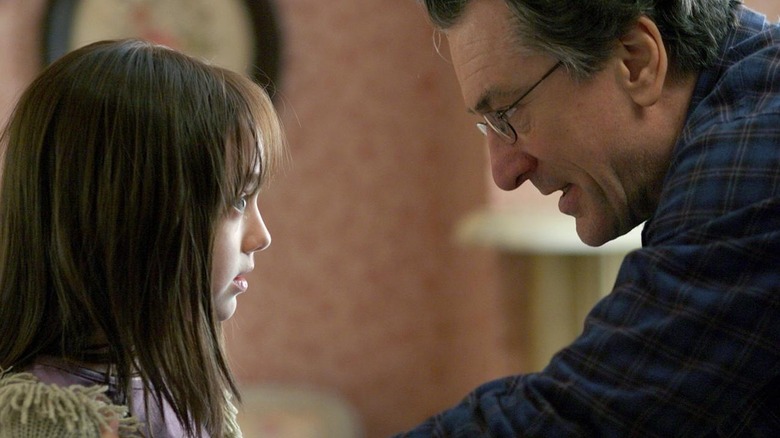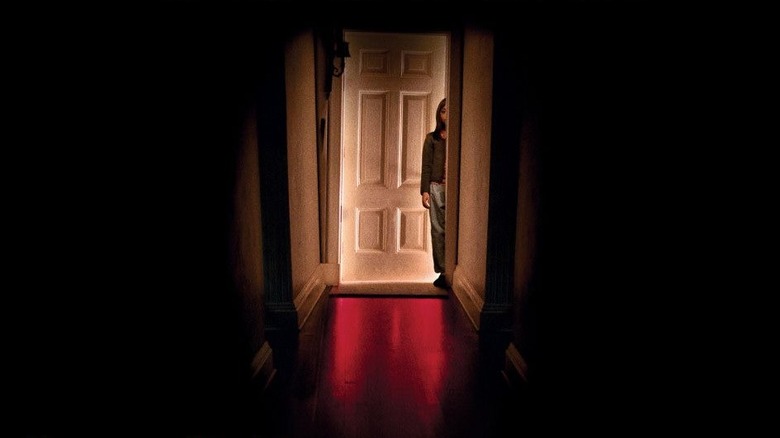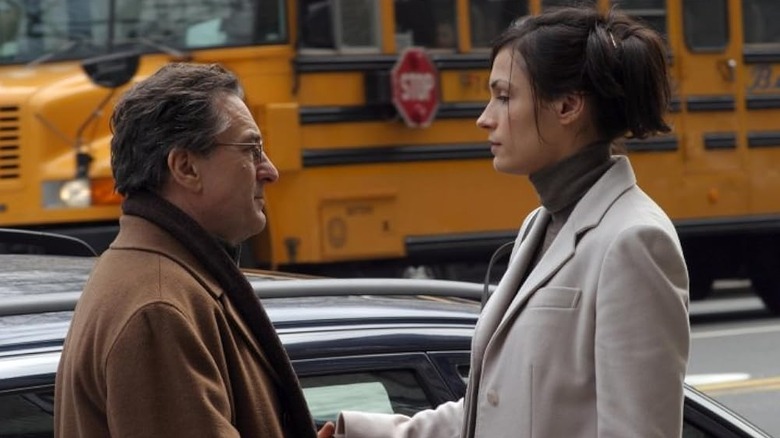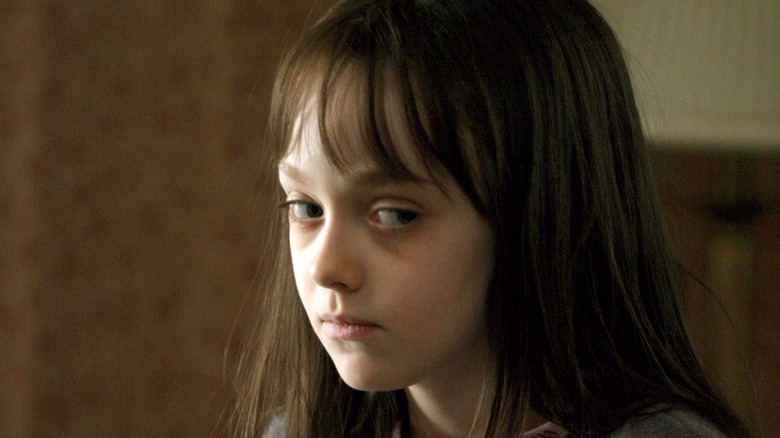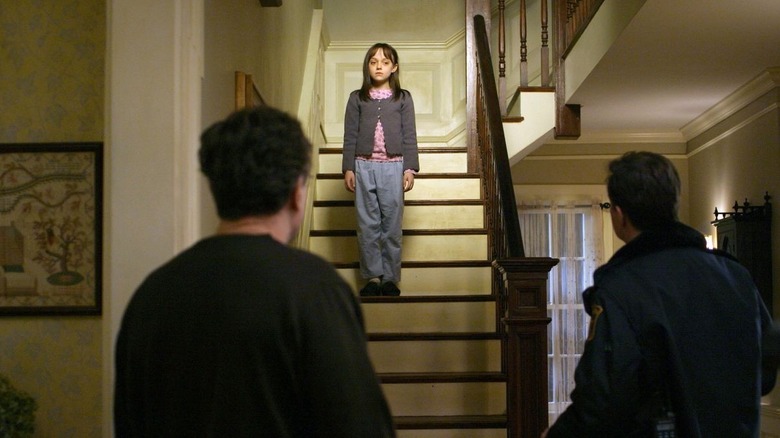20 Years Ago, A Forgotten Robert De Niro Horror Movie Was A Huge Box Office Hit
(Welcome to Tales from the Box Office, our column that examines box office miracles, disasters, and everything in between, as well as what we can learn from them.)
Horror movies may not often get a whole lot of respect, critically speaking. For whatever reason, they are often treated as a lesser form of entertainment. It's only the rarest of rare genre offerings that can go on to become embraced both critically and commercially, with Jordan Peele's "Get Out" serving as a shining example from relatively recent times. That's an outlier though. One undeniable truth though is that these movies are a reliable backbone for Hollywood studios, delivering consistent profits against relatively low investments. Good movies, bad movies, it often doesn't matter.
Hardcore horror fans will tell you that the number of bad movies far outweighs the good in any given year. It's about searching for that diamond in the rough. That's why, from time to time, a genre picture that the critical community has decried can still manage to break through and make a boatload of cash. Such was the case in 2005 when "Hide and Seek," a little-remembered thriller starring Robert De Niro and a young up-and-comer by the name of Dakota Fanning, managed to make straight-up bank before vanishing into relative obscurity. It's a relic of a time that has long since passed.
In this week's Tales from the Box Office, we're looking back at "Hide and Seek" in honor of its 20th anniversary. We'll go over how it came to be, what the landscape of moviegoing looked like at the time, how its stars elevated the proceedings, what happened when the movie hit theaters, what happened in the aftermath of its release, and what lessons we can learn from it all these years later. Let's dig in, shall we?
The movie: Hide and Seek
The film centers on psychologist David Callaway (Robert De Niro) who is reeling after his wife (Amy Irving) takes her own life. Seeking a fresh start, he decides to take his daughter Emily (Dakota Fanning) away from New York City to a house in the country. A grief-stricken Emily struggles to make new friends, save for an imaginary pal named Charlie. Or is he? Things get twisted and deadly as a series of unfortunate events unfolds before reaching a twisted conclusion.
Fox picked up the script for "Hide and Seek" in November 2002 and began developing it for the big screen. It was written by Ari Schlossberg, serving as his first feature writing credit. Perhaps tellingly, he has only one other feature credit to his name. Originally, Albert Hughes, known for his collaborations with his brother Allen Hughes such as "From Hell," was set to make his solo directorial debut but left the project in late 2003 over "creative differences," per Variety. Hughes would later go on to direct the 2018 film "Alpha," as well as episodes of the "John Wick" spin-off series "The Continental."
John Polson ("Swimfan") stepped up to the plate after Hughes departed. De Niro, meanwhile, had been attached to star in the lead role and, despite the change in directors, remained on board as he was receiving a multi-million-dollar payday for his services. It's not just that De Niro was one of the most respected actors working at the time (and arguably still is), with classics like "The Godfather Part II" and "Goodfellas" to his name, but he was hugely bankable at this time as well.
This was the era of De Niro trying to play against type. It was working quite well. He was coming off of 2000's "Meet the Parents," which was a smash hit grossing $330 million worldwide, paving the way for an even bigger sequel, 2004's "Meet the Fockers." Some of his other hits from this era include "Analyze This" and "Men of Honor." Now, he was going to front a mainstream horror film, which was yet another unexpected turn.
Hide and Seek was the wrong movie at the right time
It was no doubt because of De Niro's involvement that "a $5 script gets the $50 million treatment," as Variety put it in 2005 ahead of the film's release. It also helped secure an A-list cast around De Niro, including Famke Janssen ("X-Men"), Elisabeth Shue ("Leaving Las Vegas"), and most importantly, Dakota Fanning. The young actress had been making headway in Hollywood from a very young age, holding her own against huge movie stars like Denzel Washington in "Man on Fire" and Sean Penn in "I Am Sam."
Despite having her 10th birthday on the set of "Hide and Seek," Fanning had earned a great reputation, one that was growing with each movie. "I just forgot she's a child," Janssen said to IGN of Fanning in 2005. "There's nothing childlike about her. She's a miniature grown-up. She's very smart and very together, very talented obviously."
It's that rising star of Fanning, coupled with a beloved vet like De Niro, that elevated that so-called $5 script into something audiences actually wanted to see. In that same interview, Fanning demonstrated just how ahead-of-the-curve she was for her age, eloquently laying out why she wanted to be in this film:
"I read the whole thing and I just wanted to do it so badly, such a different character that I'd never played before, so different from myself. All the other characters I've played, I could always find something in them that's like me but with this one, there's nothing like me at all ... I was filming it, it was so intense and I had to maintain all these emotions throughout the sequences. We often had a good time when we weren't doing stuff like that."
The financial journey
Fox released "Hide and Seek" with multiple endings; one for U.S. audiences and one seen elsewhere in the world. In total, five endings of the film were shot, all of which eventually made it to DVD. The core movie stayed the same but the ending buttoned up the story differently, providing a slightly different fate for Emily. The big twist is that David is actually Charlie, as he has developed dissociative identity disorder. When a movie has this many endings, it's not often a great sign for the movie itself.
To that end, "Hide and Seek" was not embraced by critics of the day, to put it lightly. "'Hide and Seek' Does Not Deserve To Be Found," declared The Lantern at the time. It didn't matter though, as an effective trailer coupled with its stars piqued the interest of moviegoers. It also didn't hurt that the only direct competition when it opened was Lionsgate's "Alone in the Dark," considered one of the worst video game movies ever made.
"Hide and Seek" opened on January 28, 2005, debuting atop the box office domestically, pulling in $21.9 million. Against a reported $25 million production budget, that was a win for Fox. When "Boogeyman" and "The Wedding Date" opened the following weekend, De Niro's thriller fell hard, dropping nearly 60% with an $8.9 million haul. Will Smith's huge hit "Hitch" further bit into its earnings come mid-February. It hardly mattered.
The film finished its run with $51.1 million domestically to go with an outsized $76.2 million internationally for a grand total of $127.3 million worldwide. Those are returns any studio would kill for today. It would almost certainly get a sequel. In 2005 though? It was just a here today, gone tomorrow sizable cash cow.
Hide and Seek simply came and went
In 2005, the DVD market was far more healthy than it is today. We were still years from Netflix instant streaming becoming a thing. As a result, this movie went on to enjoy a nice second life on home video, boosting Fox's profits. Yet, two decades later, it's difficult to find on Blu-ray, it isn't currently on any major, paid streaming service, and currently resides on the free streamer Tubi. Even once-maligned horror movies such as Stephen King's "Graveyard Shift" have been given Blu-ray and 4K releases by boutique labels.
"Hide and Seek," on the other hand, has not been afforded any such release. It is hardly ever discussed, it seems. In fairness, several retrospective pieces have been published in the years since, and some viewers have pushed against its reputation. Reddit user tblroxdanhl4 called it a "fantastic movie" on the r/movies subreddit several years ago. But outside of internet forums and several journalists. At best, someone who saw it at the time might say something to the effect of, "Oh yeah, I remember that movie."
But that was the movie business in the early 2000s. Streaming had not yet totally altered viewing habits. People still just went to the movies because they wanted to see a movie. A movie could just be a movie — something someone did on a day ending in y after grabbing dinner. This was also when Fox was still releasing around a dozen movies per year in theaters before Disney acquired the studio in 2019 and greatly reduced that number. This movie's journey is truly representative of what the business used to look like.
The lessons contained within
Without even taking inflation into account, very few horror movies in 2024 managed to make as much money as this rarely discussed, critically panned thriller. It felt like a big deal and a cultural event when "Longlegs" hit $100 million. 20 years ago, a horror movie with a couple of big stars could sell the same number of tickets with regularity. It was business as usual, rather than a very big deal.
Looking at "Hide and Seek" now, it's a sobering reminder of just how much the business has changed. For people such as myself who cherish the theatrical experience, I miss the days when more of my peers just decided to go see a movie for the hell of it. Now, it feels like something needs to become a true event for most folks to bother. That's unfortunate. In 2025, a movie like this would either go direct-to-streaming or would most certainly flop and flop badly at the box office.
In the age of premium VOD and big new movies like "The Fall Guy" available at home mere weeks after hitting theaters, we are probably never going back to this place. In some ways, that's good. I'm not necessarily suggesting that a January movie with lousy reviews should make bank. What I am suggesting is that in the world of 2005, more movies had the chance to thrive. More filmmakers got the chance to try stuff out. It wasn't "franchise or bust."
That is missed. But fighting the future is like fighting the tide. It's best to embrace what is and work towards improving the future as best as we can, rather than wishing the past could return.
